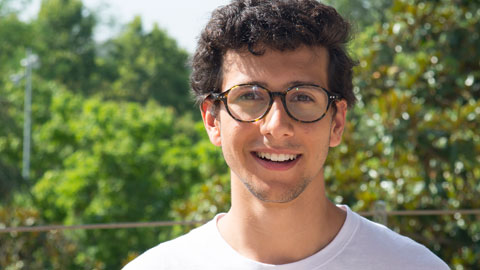"I chose the UAB because it's a good university"

13/07/2015
1. What is it about your research project that made it win the Argó first prize?
The main intention of my research project, entitled "Too many parallels! (Or too few...") was to explain non-Euclidean geometries didactically so that they could be understood by any final-year secondary school pupil with some knowledge of mathematics.
Non-Euclidean geometries, as their name suggests, are the opposite of Euclidean geometry. And what is Euclidean geometry? Well, it's the geometry we've all been taught at school, that we can draw on a piece of paper or on the blackboard. It's called Euclidean because a mathematician called Euclid wrote about it over 2,000 years ago in a textbook called "The Elements", Through five axioms Euclid was able to explain all the mathematics known up to that time. The fifth axiom postulates that, given a straight line and a point not on this line, there is only one line parallel to the given straight line that passes through that point. Later mathematicians tried to disprove this axiom, substituting "only one line parallel" with "no line parallel" or "more than one line parallel". This was the start of non-Euclidean geometries.
2. How did you go about this project (choosing the topic, getting help, etc.)?
I had five different options for the topic but in the end I went for non-Euclidean geometries, which was the most mysterious and the one I knew least about, but also the most interesting. Once I'd decided I talked to Joan Girbau, a lecturer at the Autònoma, who gave me some tips on how to approach the project. I also spoke to José Luis Ruiz, a lecturer in the UPC, who gave me a reading list on the topic.
I gradually learnt what non-Euclidean geometries were by reading various authors. When I started writing up the project I tried to explain everything just the way I would have liked it to have been explained to me.
3. Did the Argó Programme help you? Do you think it's a good initiative?
Yes I do! If not for the Argó Programme I would never have thought of doing a project on non-Euclidean geometries, and I wouldn't have found out about certain approaches to the topic. I think the Argó Programme is a great opportunity for students who want to do a good research project as it puts you in touch with teachers who are experts on each subject and who can give you advice. Also, it provides an initial contact with the university, where many of us will be heading when we leave school.
4. Now you have finished school what are you going to study at university? And why?
I've chosen physics and mathematics at the Autònoma, because I'm passionate about both these sciences: they can explain things that go on all around us every day and which we often don't pay attention to, and mathematics is a single tool that lets you solve problems in many different disciplines. And I chose the Autònoma because it's a good university, classes are in the mornings, and I've also got a grant for one year thanks to the Argó Prize.
5. What career would you like to take up in future?
I'm not sure yet. I want to focus on my studies for now and then we'll see what happens later on. Research and teaching are two options I'd consider though.